Influence of Bearing on Pier Failure Considering the Separation Condition under Near-Fault Earthquake
Abstract
:1. Introduction
2. Theoretical Model and Vertical Displacement Calculation
- (1).
- When the bridge is forced to resonate, the structural force and displacement response are always calculated by elastic deformation.
- (2).
- During seismic action, there are often stops in the lateral direction. This study only considers the coupling of vertical and longitudinal seismic activities.
- (3).
- Ignore the difference in the arrival time of the horizontal and vertical seismic waves, assuming that the earthquakes in both directions are excited at the same time.
- (4).
- The bottom of the abutment and pier is set on the hard rock, and the interaction between rock and soil is ignored.
- (5).
- The gap between the abutment and girder is ignored.
2.1. Theoretical Solution of Displacement Response of Bridge in Vertical Contact Stage
2.2. Corresponding Theoretical Solution of Bridge Vertical Separation Stage Displacement
2.3. Corresponding Theoretical Solution of Bridge Vertical Separation Stage Displacement
3. Numerical Analysis and Calculation
3.1. Effect of Vertical Separation on the Failure of Bridge Piers
3.2. Influence of Bearing Damping on the Failure of Bridge Piers
3.3. Influence of Bearing Stiffness on the Failure of Bridge Piers
4. Conclusions
- The influence of the pier and girder split on pier failure is different under different pier heights. When and , the vertical earthquake causes the separation of the girder and the pier and produces a great impact force, but the separation has little effect on the longitudinal displacement response of the bridge. When , the separation may increase the longitudinal displacement response of the girder and pier, resulting in the bending failure of the pier.
- When and , the total bending moment at the bottom of the pier changes little no matter whether it is separated or not, and most of the bending moment is produced by the forced resonance of the pier. However, the vertical impact force may reduce the allowable bending moment at the bottom of the pier and cause or aggravate the damage of the pier. When , the separation greatly increases the total bending moment at the bottom of the pier, and the collision also reduces the allowable bending moment. Therefore, in the three cases, neglecting the structural separation at may underestimate the bridge failure.
- When , the bearing damping has little effect on reducing the damage of pier. When , due to the longitudinal resonance effect, the increased damping can greatly reduce the bending moment at the bottom of the pier. When , the bending moment at the bottom of the pier decreases slowly with the increase of damping, especially when considering separation. Simply increasing the bearing damping cannot reduce the damage of the pier.
- With the increase of the bearing’s stiffness, the longitudinal relative displacement of the pier and beam has little change under the three conditions, but the vertical collision force increases monotonously with the increase of pier stiffness. When and , the total bending moment changes little with the increase of stiffness and the allowable bending moment decreases gradually, which may cause or aggravate the pier failure. While , with the increase of bearing stiffness, the total bending moment increases gradually, and the allowable bending moment decreases gradually when considering separation. Compared with the first two cases, the bearing stiffness has the greatest impact on the pier failure.
Author Contributions
Funding
Institutional Review Board Statement
Informed Consent Statement
Data Availability Statement
Conflicts of Interest
References
- Li, H.N.; Xiao, S.Y.; Huo, L.S. Damage investigation and analysis of Engineering structures in the Wenchuan earthquake. J. Build. Struct. 2008, 29, 10–19. [Google Scholar]
- Zhuang, W.L.; Liu, Z.Y.; Jiang, J.S. Earthquake-induced damage analysis of highway bridges in Wenchuan earthquake and countermeasures. Chin. J. Rock Mech. Eng. 2009, 28, 1377–1387. [Google Scholar]
- Xu, S.Y.; Zhang, J. Axial–shear–flexure interaction hysteretic model for RC columns under combined actions. Eng. Struct. 2012, 34, 548–563. [Google Scholar] [CrossRef]
- Ghannoum, W.M.; Mohle, J.P. Rotation-Based Shear Failure Model for Lightly Confined RC Columns. J. Struct. Eng. 2012, 138, 1267–1278. [Google Scholar] [CrossRef]
- Elwood, K.J. Modelling failures in existing reinforced concrete columns. Can. J. Civ. Eng. 2004, 31, 846–859. [Google Scholar] [CrossRef]
- Cimellaro, G.P.; Domaneschi, M.; Warn, G. Three-Dimensional base isolation using vertical negative stiffness devices. J. Earthq. Eng. 2020, 24, 2004–2032. [Google Scholar] [CrossRef]
- Wilson, T.; Chen, S.; Mahmoud, H. Analytical case study on the seismic performance of a curved and skewed reinforced concrete bridge under vertical ground motion. Eng. Struct. 2015, 100, 128–136. [Google Scholar] [CrossRef]
- Kunnath, S.K.; Erduran, E.; Chai, Y.H.; Yashinsky, M. Effect of near-fault vertical ground motions on seismic response of high overcrossings. J. Bridge Eng. 2008, 13, 282–290. [Google Scholar] [CrossRef]
- Yu, C.P. Effect of Vertical Earthquake Components on Bridge Response. Ph.D. Thesis, University of Texas, Austin, TX, USA, 1998. [Google Scholar]
- Papazoglou, A.J.; Elnashai, A.S. Analytical and field evidence of the damaging effect of vertical earthquake ground motion. Earthq. Eng. Struct. Dyn. 1996, 25, 1109–1137. [Google Scholar] [CrossRef]
- Varecac, D.; Draganic, H.; Gazic, G. Influence of the Vertical Component of Earthquake on Large Span Rc Beams. Tehnicki Vjesnik 2010, 17, 357–366. [Google Scholar]
- Kim, S.J.; Holub, C.J.; Elnashai, A.S. Experimental investigation of the behavior of RC bridge piers subjected to horizontal and vertical earthquake motion. Eng. Struct. 2011, 33, 2221–2235. [Google Scholar] [CrossRef]
- Kim, S.J.; Holub, C.J.; Elnashai, A.S. Analytical Assessment of the Effect of Vertical Earthquake Motion on RC Bridge Piers. J. Struct. Eng. 2011, 137, 252–260. [Google Scholar] [CrossRef]
- Zheng, W.; Leonardo, D.O.; Jamie, E.P. Seismic response of a bridge-soil-foundation system under the combined effect of vertical and horizontal ground motions. Earthq. Eng. Struct. Dyn. 2012, 4, 545–564. [Google Scholar]
- Bozorgnia, Y.; Niazi, M.; Campbell, K.W. Characteristics of Free-Field Vertical Ground Motion during the Northridge Earthquake. Earthq. Spectra 1995, 11, 515–525. [Google Scholar] [CrossRef]
- Wang, G.-Q.; Zhou, X.-Y.; Zhang, P.-Z.; Igel, H. Characteristics of amplitude and duration for near fault strong ground motion from the 1999 Chi-Chi, Taiwan Earthquake. Soil Dyn. Earthq. Eng. 2002, 22, 73–96. [Google Scholar] [CrossRef]
- Wang, D.; Xie, L. Attenuation of peak ground accelerations from the great Wenchuan earthquake. Earthq. Eng. Eng. Vib. 2009, 8, 179–188. [Google Scholar] [CrossRef]
- Wang, C.J.; Shih, M.H. Performance study of a bridge involving sliding decks and pounded abutment during a violent earthquake. Eng. Struct. 2007, 29, 802–812. [Google Scholar] [CrossRef]
- Zuo, Y.; Sun, G.J.; Li, H.J. Comparison and Research of Unseating Prevention Measures in Seismic Codes of China and Foreign Countries. J. Disaster Prev. Mitig. Eng. 2016, 36, 617–623, 639. [Google Scholar]
- Han, W.; Song, C.; Li, Q. Strong ground motion at meizoseisal area & safety of important engineering projects at potential earthquake region. J. Eng. Geol. 2004, 12, 346–353. [Google Scholar]
- Tanimura, S.; Mimura, K.; Nonaka, T.; Zhu, W. Dynamic failure of structures due to the great Hanshin-Awaji earthquake. Int. J. Impact Eng. 2000, 24, 583–596. [Google Scholar] [CrossRef]
- Yang, H.; Yin, X.; Hao, H.; Bi, K. Theoretical Investigation of Bridge Seismic Responses with Pounding under Near-Fault Vertical Ground Motions. Adv. Struct. Eng. 2015, 18, 453–468. [Google Scholar] [CrossRef] [Green Version]
- Xing, Y.F.; Wang, L.J. Analysis of wave propagation in the built-up structures of rod-beam and beam-beam. J. Beijing Univ. Aeronaut. Astronaut. 2013, 30, 520–523. [Google Scholar]
- CJJ 166-2011. Code for Seismic Design of Urban Bridges; Ministry of Housing and Urban-Rural Development of the People’s Republic of China: Beijing, China, 2011.
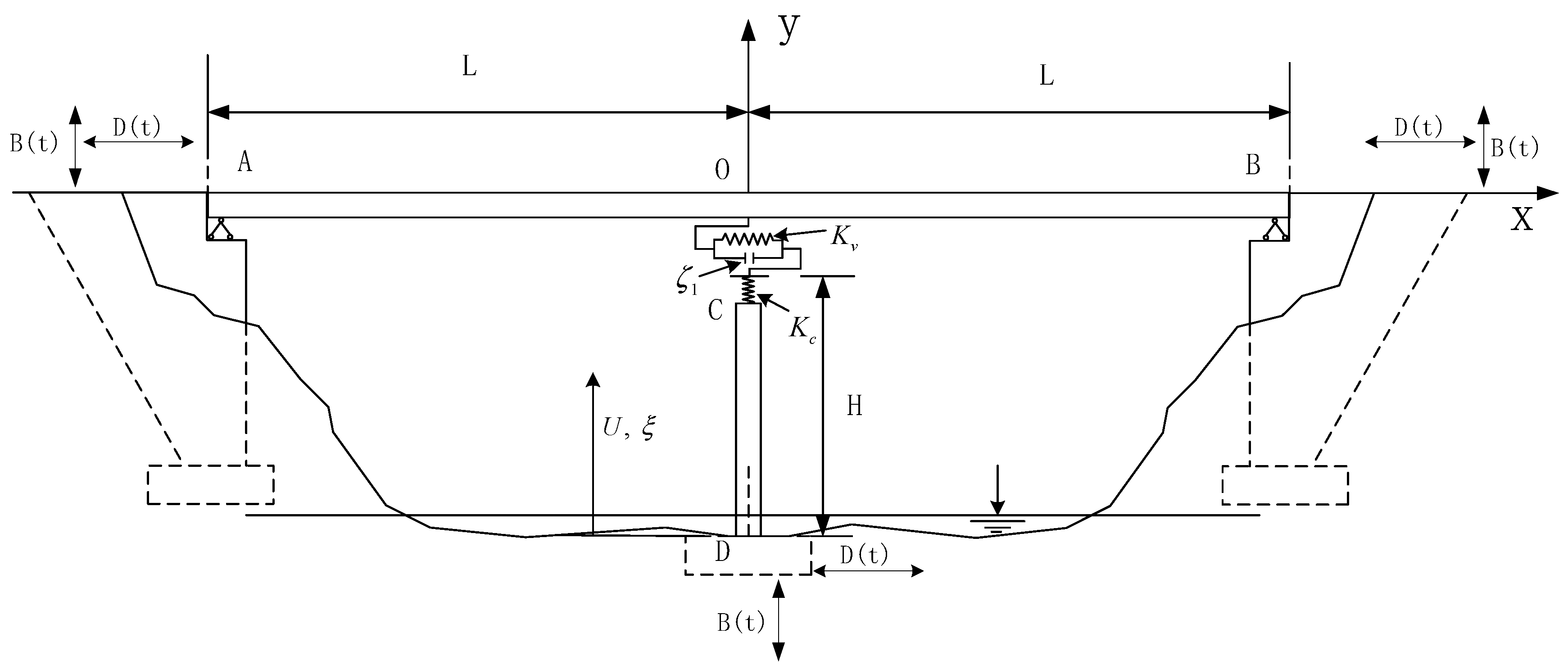
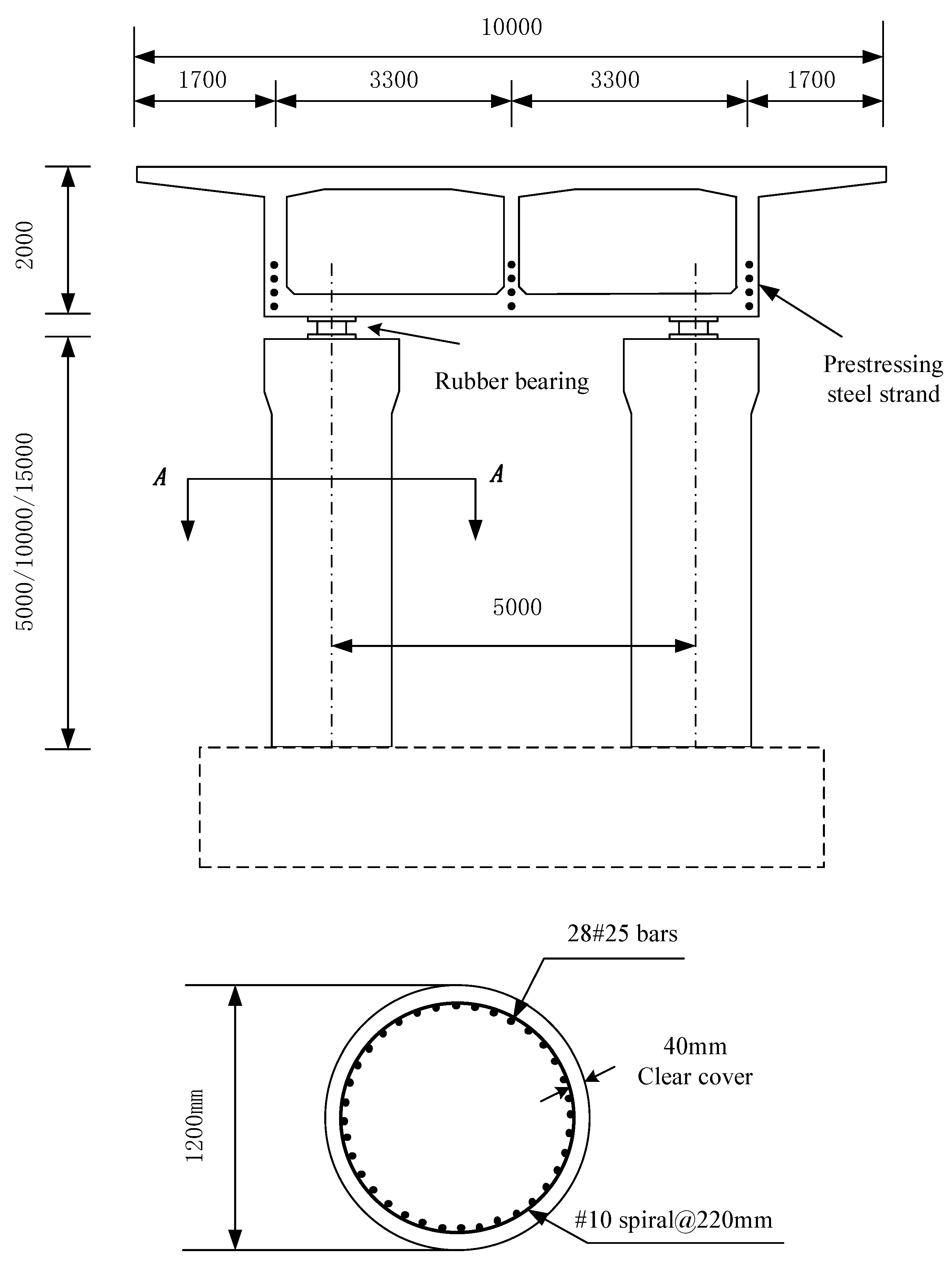

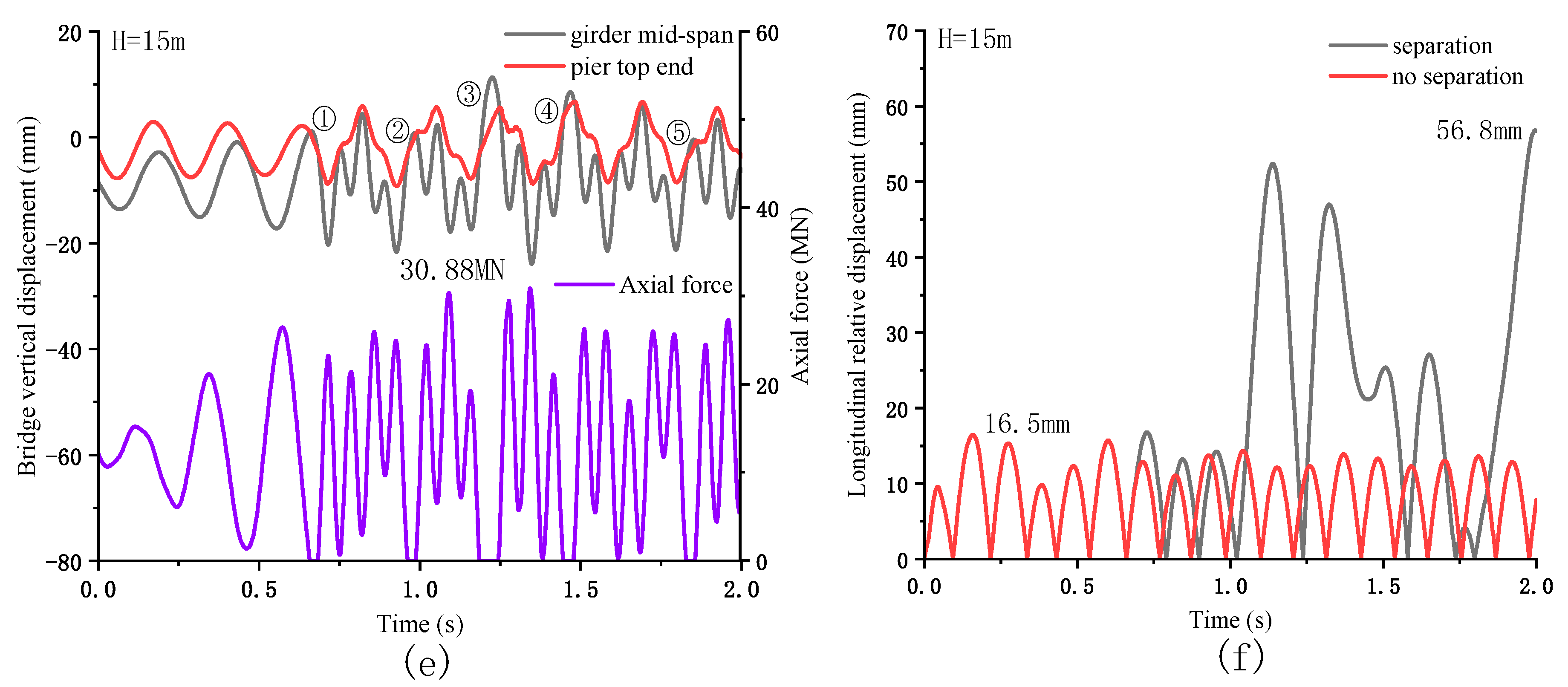

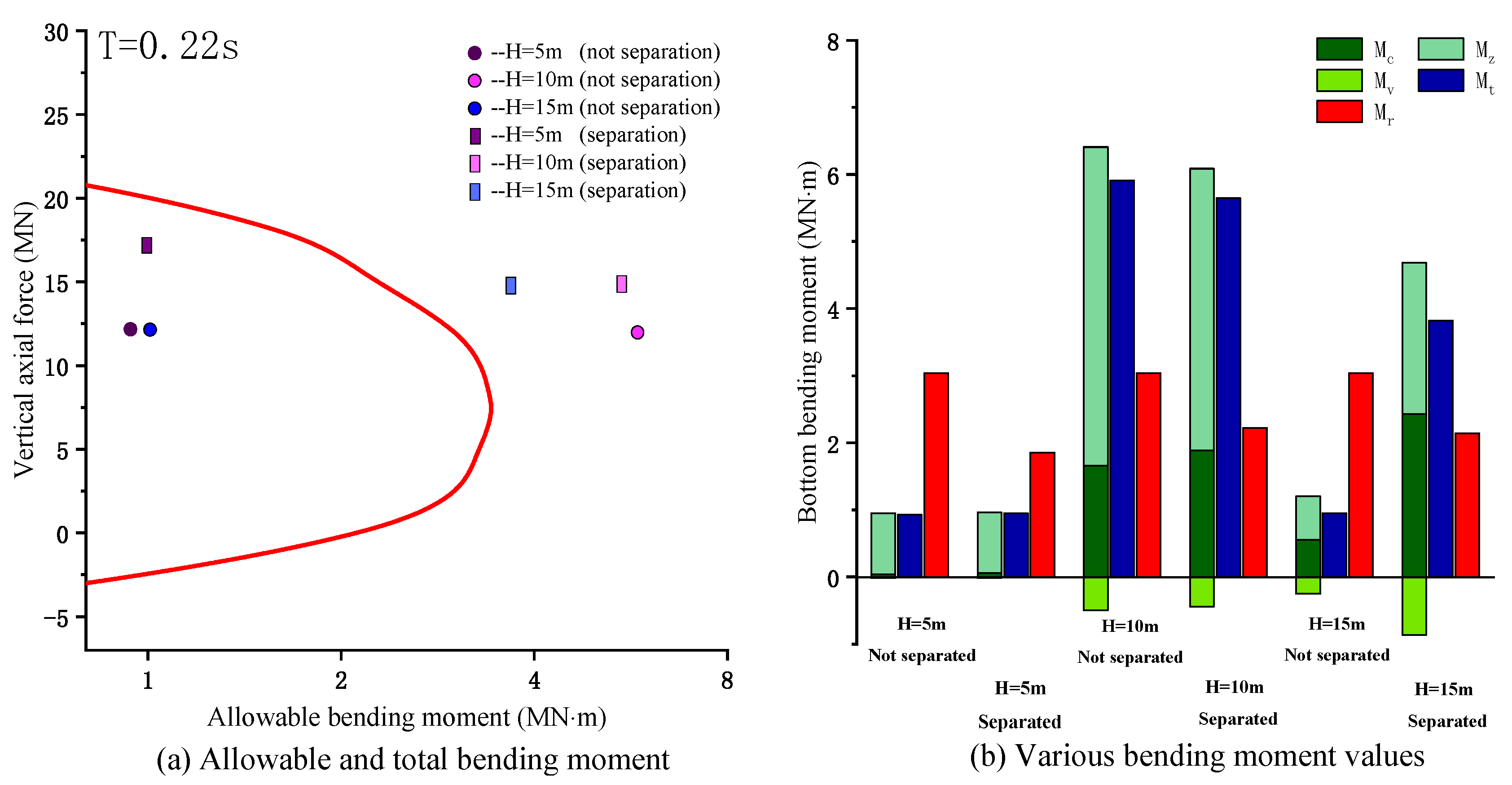

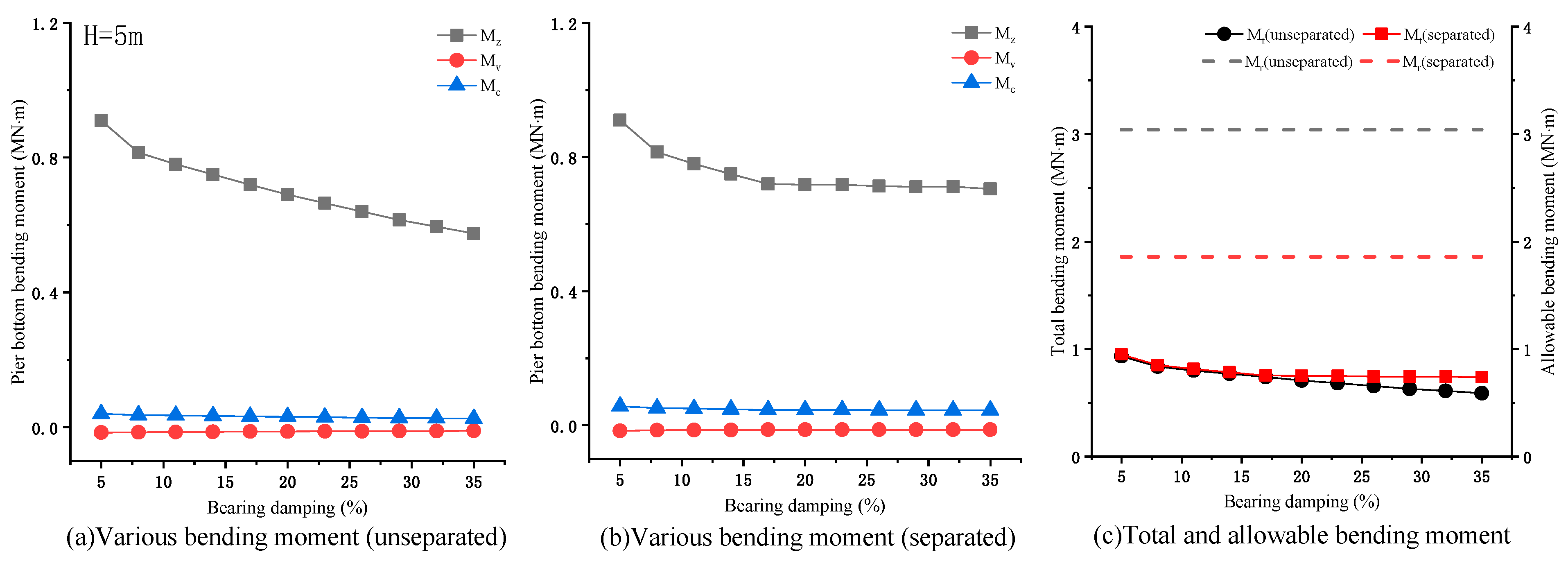


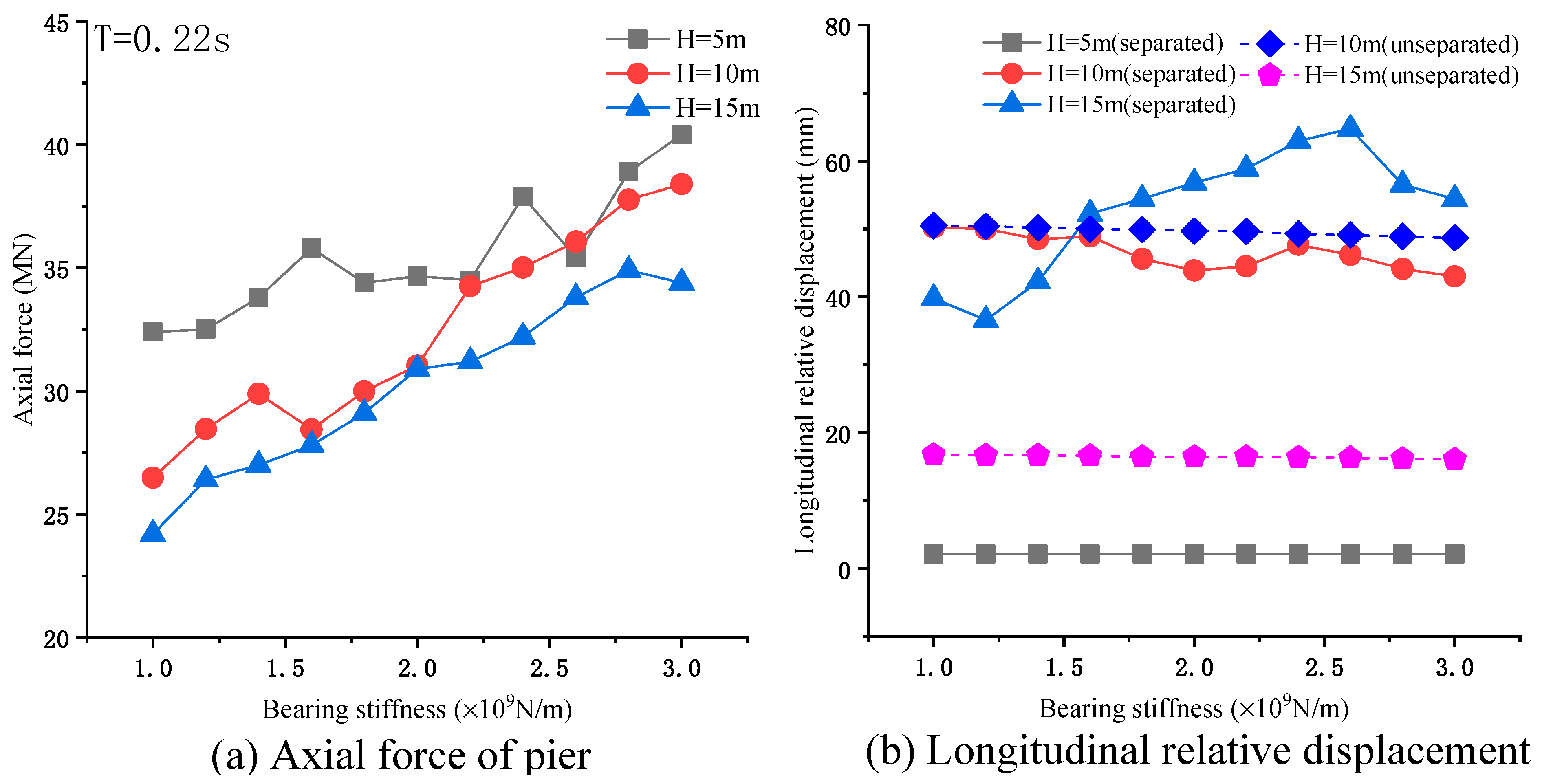


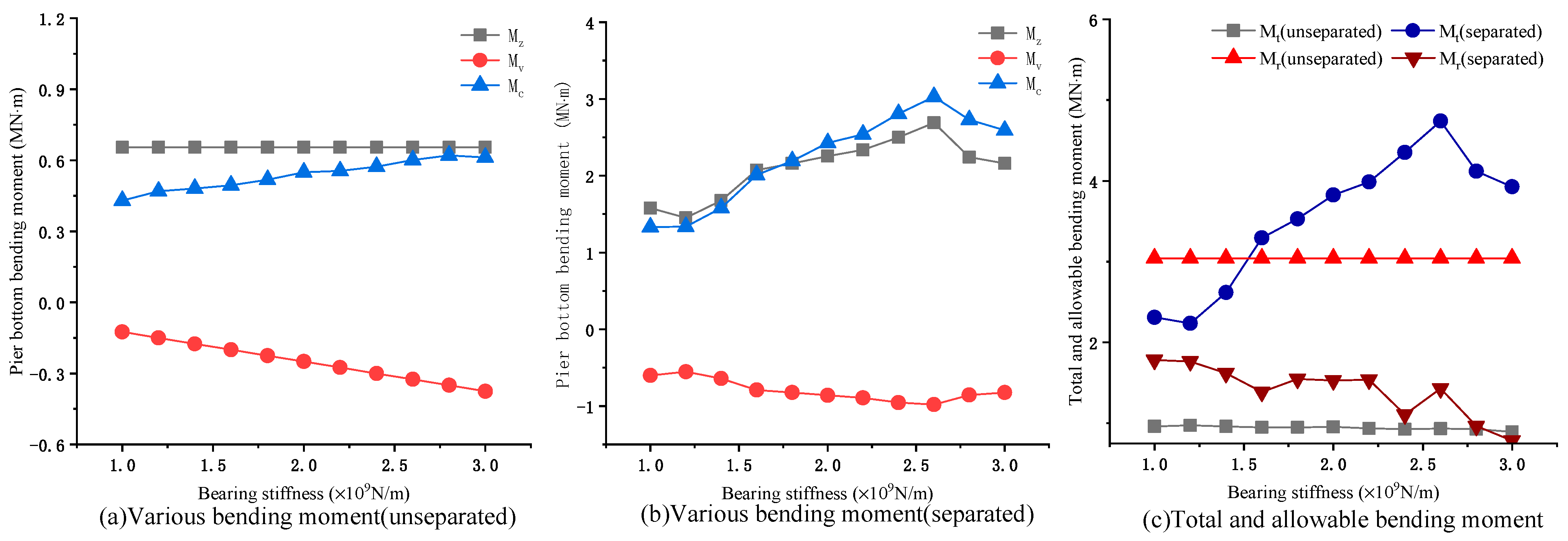
Publisher’s Note: MDPI stays neutral with regard to jurisdictional claims in published maps and institutional affiliations. |
© 2021 by the authors. Licensee MDPI, Basel, Switzerland. This article is an open access article distributed under the terms and conditions of the Creative Commons Attribution (CC BY) license (https://creativecommons.org/licenses/by/4.0/).
Share and Cite
An, W.; Song, G. Influence of Bearing on Pier Failure Considering the Separation Condition under Near-Fault Earthquake. Symmetry 2021, 13, 692. https://doi.org/10.3390/sym13040692
An W, Song G. Influence of Bearing on Pier Failure Considering the Separation Condition under Near-Fault Earthquake. Symmetry. 2021; 13(4):692. https://doi.org/10.3390/sym13040692
Chicago/Turabian StyleAn, Wenjun, and Guquan Song. 2021. "Influence of Bearing on Pier Failure Considering the Separation Condition under Near-Fault Earthquake" Symmetry 13, no. 4: 692. https://doi.org/10.3390/sym13040692




